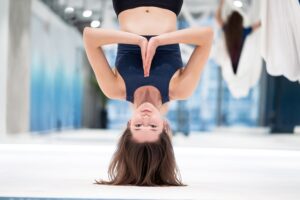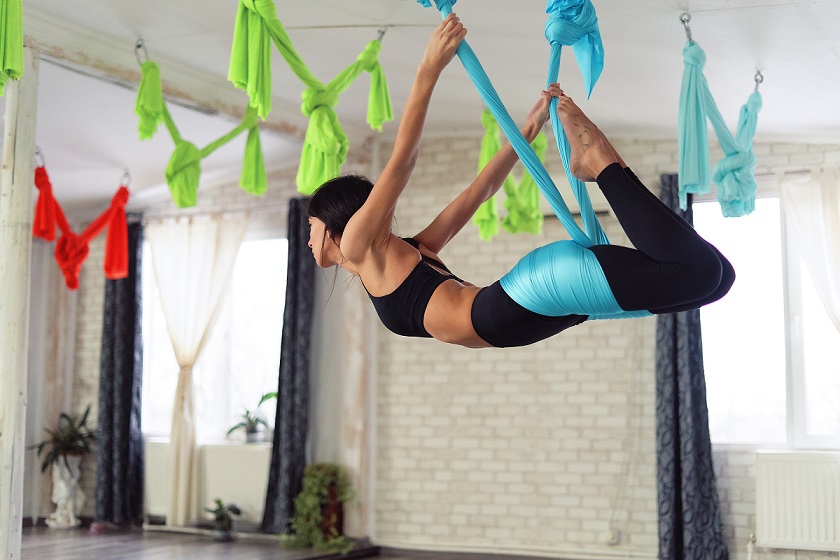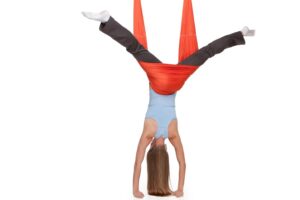Advanced Aerial Yoga Postures:
Aerial yoga may just be the ultimate tool for fitness and mindfulness. With a good yoga hammock and knowledge of aerial yoga postures, yogis can take their yoga to the next level, helping to deepen in your pose and ultimately improve flexibility and strength. In this post, we’ll be talking about more advanced aerial yoga postures.
In previous discussions we’ve talked specifically about more beginner aerial yoga asanas, as well as some of the equipment used.

To take advantage of this yoga technique, you may need to start with some of those aforementioned basic aerial yoga postures until you get into the “swing” of things. Upping the intensity of your yoga practice can certainly be obtained by giving advanced aerial yoga a try.
Aerial yoga (or antigravity yoga) is touted to help reduce pain, realign the spine, and increase flexibility. Advanced aerial yoga may be able to enhance these benefits, reaching your fitness goals, faster. When performing aerial yoga, you will be executing many of the same poses done on your yoga mat, just now suspended in the air.
Like other yoga props, the hammock/swing can be used to challenge you as a yogi, and/or help support you in developing more stretch and strength.
Advanced aerial yoga can also keep you more in touch with your body as it brings a different type of physical awareness. Some yogi’s find specific poses extremely challenging, like inversions, do to pressure on the neck and spine, as well as weakness in their arms and shoulders. With the help of a hammock, these asanas become more executable for beginner and intermediate yogi’s.

Significant Advantages of Aerial Yoga Practices
Aerial yoga offers a plethora of physical, mental, and emotional benefits that set it apart from traditional yoga practices. In the following section, we will delve into these advantages, highlighting how aerial yoga can transform your well-being, flexibility, and overall fitness. Let’s explore the numerous reasons why aerial yoga has gained popularity and acclaim in the world of fitness and wellness.
Confidence:
In various phases of our lives, we seek avenues for personal improvement, both physically and mentally. Embarking on the journey of aerial yoga not only introduces an element of excitement but also presents a significant mental challenge. It’s an entirely new experience for most individuals, which can be exhilarating yet slightly nerve-wracking.
Consequently, mastering specific aerial yoga poses and focusing on precise execution can elevate your mental fortitude. This newfound confidence not only applies to your performance in aerial yoga but also extends to your practice on the traditional yoga mat.
Aerial yoga often involves suspension in mid-air, a moment that can feel like confronting your fears head-on for some practitioners. The accomplishment of performing exercises while suspended in the air can be a powerful confidence boost, enhancing your overall fitness self-assurance.
Strength & Flexibility:
The Yoga Hot Spot (with locations in New York), discusses the ability of aerial yoga to help maintain great range of motion by consistently working on your flexibility, which aerial yoga can help achieve. Not only does aerial yoga allow you for an opportunity to safely stretch your muscles and joints (they write in there post), but may also give you additional space to move about.
You might imagine, due to the constant tension on your upper arms and the core to help stabilize yourself in the air, the additional strength that you may see in these areas.
During aerial yoga you will be holding onto a silk hammock for the duration of the session, and engaging your core to help move about and execute the asanas. Furthermore, while engaging areas of your body, you may also increase blood flow to those areas, allowing for strength gains through additional nutrient transport.
Related Article: Yoga Poses for Abs: What you Need to Know About Yoga and Increasing Core Strength
Better Mat “Game”:
If you think about the fact you are often deepening your positions, coupled with combining skills of gymnastics, Pilates and acrobatics, it only makes sense, that when getting back to “yoga on the mat”, you tend to improve your overall yoga game.
Having trouble getting those tricky headstand or forearm stands down? Try some advanced aerial yoga poses!
Keep in mind that oftentimes these classes are led by an instructor, whether at home or in the gym (given the rise of virtual classes). Many instructors offer a variety in training, as aerial yoga can be restorative, meditative, even more face-paced. Point is, many forms of yoga you do on the yoga mat, can be done via aerial yoga.
Related Article: What is Meditation: What Are Some of The Different Types of Meditation?
Easy on the Body:
Please don’t mistake this for an assertion that aerial yoga is an easy practice! What we’re emphasizing here is its unique impact on the body, particularly the muscles and joints. Aerial yoga provides a blend of comfort, cardio, and strength training precisely because it alleviates constant pressure on joints such as the knees, ankles, and hips.
Advanced Aerial Yoga Pose:
In this section, we will unravel the world of advanced aerial yoga poses, each presenting a unique challenge and opportunity for growth in your yoga practice. These poses push the boundaries of strength, flexibility, and balance, providing a thrilling and rewarding experience. Join us as we explore the intricacies of these advanced aerial yoga poses and discover how they can elevate your yoga journey to new heights.
One-Legged King Pigeon Pose Variation (Eka Pada Rajakapotasana) Variation Aerial:
This intermediate level pose has several variations. The One-Legged King Pigeon pose is not just a test of balance and strength, but also provides an excellent stretch. It targets your core, hamstrings, hips, quads, and shoulders.
| Step | Description |
|---|---|
| 1. | Start by getting into an aerial reclined angle pose. |
| 2. | Lift your head to position your legs. Extend one leg straight out to the side, while bending the other sideways. The outer foot of the bent leg should wrap around your hammock. |
| 3. | After wrapping your foot, focus on bending the other leg. Rotate your thigh so it faces upward, as if you’re sitting. Bend your leg forward, point your foot down, then lower your head back towards the ground. |
Aerial Star Inversion (Utthita Tadasana Viparita Aerial):
| Step | Instruction |
|---|---|
| 1. | Sit in your yoga hammock, lean back, and bring your knees toward your core, engaging your core muscles. |
| 2. | Spread your legs into a straddle position. |
| 3. | Lean back sufficiently to flip backward and become inverted, then widen your legs further. |
| 4. | Guide your hands down toward the floor, ensuring the back of your hands touch the ground. |
Inverted Eagle Pose (Inverted Garudasana Variation Aerial):
The Inverted Eagle Pose is yet again another advanced aerial yoga asana. It requires strength and balance. This pose can equate to a nice stretch for the upper and lower back, arms and shoulders.
| Step | Instruction |
|---|---|
| 1. | Set the yoga silk slightly above your hips. Lean back to achieve a reclining position. |
| 2. | Invert your body by pulling your knees toward your chest and activating your abdominal muscles. |
| 3. | Position yourself so your head is near the floor and your legs are elevated, inverted. |
| 4. | Firmly place your hands on the ground, palms facing downward, for stability. Cross your left knee over your right knee at the back. |
| 5. | Entwine your hands together. Alternate the leg position by crossing your right knee over your left knee. |
Inverted Bow Pose (Inverted Dhanurasana Aerial):
The Inverted Bow Pose, another advanced aerial yoga pose, is an inversion, back-bend, stretch and balance type pose. If done correctly this pose can help bring focus to the arms, shoulders, back, core, hips, and quads.
| Step | Instruction |
|---|---|
| 1. | Start by sitting in your hammock. The fabric should be under your buttocks and extend upwards around your waist. |
| 2. | Hold the sides of the hammock with each hand, lean back, and stabilize your position. |
| 3. | Gradually release your grip. Your head should be suspended in the air, not touching the floor. |
| 4. | Reach back towards your feet with your hands or fingers. Maintain this position and breathe deeply for 3-5 breath cycles. |
Handstand Pose Aerial (Adho Mukha Vrksasana Aerial):

Sticking with the theme of this post, the Handstand Aerial Pose in another advanced aerial yoga pose. Both strength and balance come into play when maneuvering into this inverted pose.
| Step | Instruction |
|---|---|
| 1. | Sit in your hammock and lean back, allowing your body to straddle the yoga silk, achieving a fully inverted position. |
| 2. | Wrap your feet securely in the silks to maintain stability. |
| 3. | While remaining fully inverted with your legs wrapped, place your hands on the ground and extend your body into a handstand pose. |
| 4. | Utilize the support of the silks to reduce some of the weight on your arms, although this pose still demands significant arm strength. |
Final Thoughts:
These advanced aerial yoga poses offer a unique and exhilarating way to enhance your yoga practice. As you explore these challenging poses, consider incorporating some modifications and the use of yoga props to tailor the practice to your level of comfort and ability. Here are a few ideas:
- Modifications: If you’re new to aerial yoga or still building your strength and balance, start with simpler variations of these poses. For example, in the Inverted Eagle Pose, you can keep your feet closer to the ground before attempting a full inversion. Gradually work your way up to the advanced versions.
- Yoga Props: Utilize yoga props such as yoga blocks or cushions to provide additional support during these poses. Placing a cushion under your head in the Inverted Bow Pose can make it more comfortable, especially if you’re working on your flexibility.
- Professional Guidance: It’s advisable to practice these advanced poses under the guidance of a certified aerial yoga instructor. They can provide personalized tips and ensure your safety throughout the practice.
- Progressive Training: Set achievable goals for yourself and progressively challenge your abilities. Track your progress and celebrate your achievements along the way.
By incorporating these suggestions, you can make the journey of mastering advanced aerial yoga poses more accessible and enjoyable. Remember that safety and gradual progress are key in any yoga practice. We hope these poses inspire you to take your yoga game to new heights and conquer your fitness challenges with confidence.
Thank you for visiting our blog, and we encourage you to share your experiences with advanced aerial yoga on your social media platforms. Your journey can inspire others to explore the world of aerial yoga and discover its incredible benefits. Keep flying high and embracing the beauty of aerial yoga!
References:




